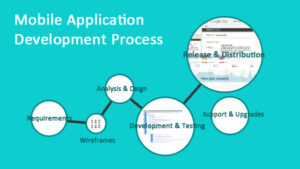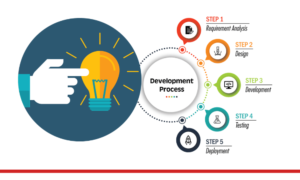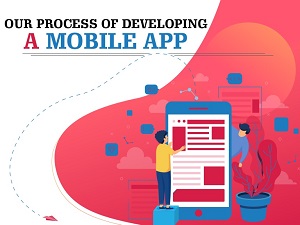It is proved in many surveys that over a fourth of internet traffic is from mobile applications. Smartphone users rely a lot on mobile apps rather than other browser versions for their day to day requirements and mobile activities. Be it communication, entertainment, shopping and any others. So today, in this fast-growing digital era, every business enterprise needs to take their business more closely into the market via app development strategies. For this, they need to cultivate an outstanding and flawless mobile app development strategy and this is possible only by adopting a proper mobile app development process and following it thoroughly.
Here, we let you know in detail about the key stages in the mobile app development process.
1. Strategy
Not every idea can be cultivated into an app and not every app becomes successful though. It is important to have a proven strategy and follow it to yield your idea into an app that attracts users.
A well-structured strategy involves a few questions to ask yourself. They include:
What is the app for?
Who are your target users?
Who are your competitors in the market?
What is the best suitable mobile platform for your app?
With these in mind, you have the clear strategy of your budding app in mind and so, you could easily jump into the next level of the mobile application development process.
2. Analysis and Planning
 This is where your app takes its original and final route map to turn out into a finished product. For this, you need to design a roadmap that constitutes the functional requirements for your app, the necessary use cases. When you have assessed and grouped the requirements for your app’s development including the target time, estimated cost of development and other resources, you have made it into the launch.
This is where your app takes its original and final route map to turn out into a finished product. For this, you need to design a roadmap that constitutes the functional requirements for your app, the necessary use cases. When you have assessed and grouped the requirements for your app’s development including the target time, estimated cost of development and other resources, you have made it into the launch.
The analysis includes which platforms your app is targeted onto. iOS, Android and Windows. If so, you need to deploy different app developers for different platforms to make sure your app is flawless.
Planning here starts from your app’s name in the app store. Ensure that your app name is unique yet catchy, easily memorable by the users. Also, it should not contain any replicas or duplicate names in the app store. For doing so, you need to perform an app store research for making sure your app’s name is not already included.
3. UI and UX designing
This stage includes users’ adoption policies. For any app to sustain and succeed, it has to have a well-equipped and designed user interface. Seamless navigation, attractive user interface design can lure users to adopt the app. Whereas, UX- user experience design should be in such a way that it engages the users for a long time. A well-structured interface lets the users interact with the app and its features. And a flawless menu, error-free page experience decides whether your UX design has succeeded or failed. So, the more furnished and intuitive your app’s UI and UX designing are, the more is the success rate for it.
And workflows, wireframes, style guides and mockups. Let us see through these four designing elements.
Workflow construction uses diagrams depicting the data outflow and inflow within the app. The workflow diagrams show how users interact with the app, what data does it collects and reflects. Overall, these represent the user interaction process and navigation within the app.
Wireframes are nothing but the digital forms of app design sketches that the designers work with. How the app’s functionality would look like and the user experience is more concentrated in these work frames.
Styleguide includes the type of font you zero in for your app. The colour palette, the size of the logo of your brand etc. Further, the type of style guide you adopt for your app should be device-specific – different for different mobile platforms.
Mockups are another important part of your app’s development process. The style guide you have finalized for your app is applied to the wireframes designed prior.
4. App Development This stage of app development is nothing but programming the app. It involves analyzing the technology, technical architecture, requirements and functionalities. The app programming typically includes three phases and they are explained in brief below.
a) Backend programming: Backend technology is nothing but server or database to support the functions of your app. To achieve the planned mobile functionalities you require the right database or in case there is an existing database it requires any modifications further.
b) APIs: The communication system built between backend technology and the actual app.
c) Front-end programming: To develop the front-end, the actual app it is, you need to finalise on a programming language which is different for different mobile platforms. iOS apps and android apps run using their respective technology stacks. Whereas a backend can be programmed using any web programming language and database as a choice. All that you need is the aptest choice made for your mobile app’s usage.
5. Testing
This stage in the mobile development process is crucial as much as designing and programming since it results in security, reliability and loyalty that your app gains. Quality assurance testing involves the usage of test cases by the testing team. To get the right mark without any flaws, your app needs to undergo the below testing methods.
a) User Experience Testing: The visual impression, interaction with the users, and the flow of navigation everything comes under the user experience. The final impression that a user has on the app is what relates to this testing. Right from the font styles to colour schemes and icons and their placements, the in-app functionalities should match the initial designs and mockups of your app.
b) Functional Testing: An app’s functionalities are tested based on the scenarios of how an end-user is going to use the app. What bugs he may experience, what outputs are going to be mismatched and other functional features are tested basing mock users’ experiences.
c) Performance Testing: Completely different from functional testing. It measures the speed of your app, its consumption of user’s phone memory, battery draining, internet connection and speed requirements. This may vary with the increase of decrease in the number of users. So, you need to test the app’s performance with as many users as possible. Finally, the app’s performance capability should be maximum.
d) Security testing: To ensure user data safety and security, the app’s development team needs to deploy a separate security assistance team. The login session timeout length, user credentials, data storage both in front-end and server should be monitored and secured to ensure there are not data leakages and vulnerability to hacks.
e) Platform testing: Testing your final app on different mobile platforms and different mobile devices is as much important since we do see a new mobile device popping up from mobile giants every few months. Also, our mobile operating systems keep on updating frequently. So, to check whether the app can adapt to the new devices and updated mobile OS, it is needed to perform mobile device testing.
6. Deployment
Once you are done with the testing methods and yielded good results, the next and final stage of a mobile app development process is to submit the app to the app stores – Apple app store and Google play store. But for this, you need to keep hold of some details regarding your app like – app title, description, purpose, keywords and icon.
development process is to submit the app to the app stores – Apple app store and Google play store. But for this, you need to keep hold of some details regarding your app like – app title, description, purpose, keywords and icon.
Once done with the data collection and submission, Google play store directly approves your app to be available on the app store regardless of the review process. Whereas your app to be available on the Apple app store, it needs to undergo a review process which may take from days to weeks.
Once your app is available on the app store of the mobile platforms, you have to keep track of the user reviews, feedbacks, reported issues, etc., to improve any quality or functional related issues and bugs. This proves to increase the users’ loyalty and engage them with the app’s updates. However, an update of the app also needs to go through the same submission, review and acceptance process from the app store. So, keep updating your app with respect to the technological advancements and latest mobile devices.
All the best for your mobile app development.
Also read: 7 Top Reasons Why Mobile App Marketing Is Crucial

